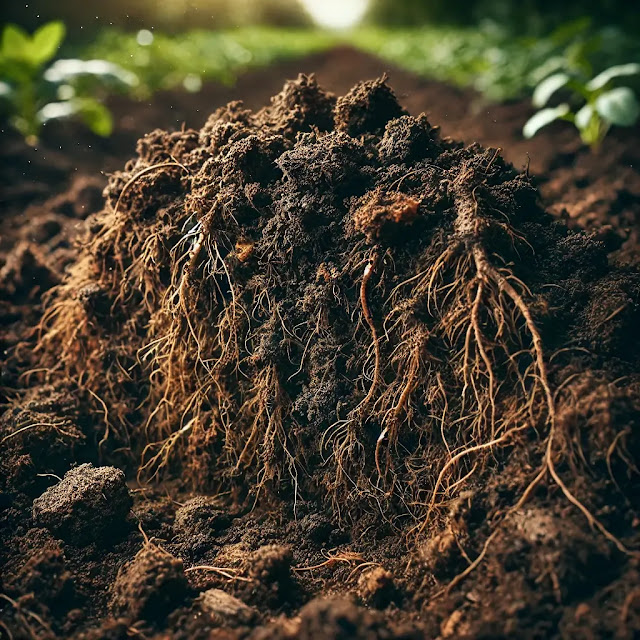.webp) |
| sustainable agricultural landscape.jpg |
What is Regenerative Agriculture?
Regenerative agriculture focuses on restoring and enhancing the natural processes of ecosystems. Unlike conventional agriculture, which can deplete resources, regenerative practices aim to replenish them. Key principles of regenerative farming include soil health, biodiversity enhancement, water management, and carbon sequestration.
- Soil Health: Practices like minimizing soil disturbance, using compost, and applying organic fertilizers contribute to building healthier soils that can better retain nutrients and moisture. Learn more about soil health on the Food and Agriculture Organization (FAO).
.webp)
nutrient-rich soil with organic matter.jpg - Biodiversity: Crop rotation, cover cropping, and integrating livestock help create diverse ecosystems that are more resilient to pests and diseases.
- Water Management: Techniques such as rainwater harvesting and contour farming improve water retention, reduce runoff, and conserve resources.
- Carbon Sequestration: Regenerative methods like cover cropping, agroforestry, and rotational grazing encourage carbon storage in the soil, which helps reduce atmospheric CO₂ levels. Learn more about regenerative carbon storage at Project Drawdown.
Benefits of Regenerative Agriculture
Regenerative agriculture offers numerous environmental, economic, and health benefits:
- Soil Enrichment: Healthier soils promote plant growth, improve nutrient density in crops, and increase resilience against droughts.
- Increased Biodiversity: Diverse ecosystems support beneficial insects, natural pest control, and better ecosystem stability.
- Climate Change Mitigation: By capturing carbon in the soil, regenerative practices reduce greenhouse gas emissions.
- Improved Food Quality: Crops grown in healthy soil are often richer in vitamins, minerals, and antioxidants.
- Economic Benefits for Farmers: Regenerative farms tend to rely less on synthetic fertilizers and pesticides, which can lower costs and improve profitability in the long run.
Studies estimate that regenerative agriculture could sequester a substantial amount of global CO₂ emissions, making it a promising approach to address climate change.
Key Techniques in Regenerative Agriculture
.webp) |
| demonstrating biodiversity in agriculture.jpg |
- No-Till Farming: This method reduces soil disturbance, preserves soil structure, and retains moisture, making it essential for healthy soil.
- Cover Cropping: Cover crops prevent erosion, add organic matter to the soil, and suppress weeds, all of which enhance soil health.
- Agroforestry: Combining trees with crops increases biodiversity, sequesters carbon, and can provide additional income sources through products like timber and fruit.
- Rotational Grazing: This technique allows animals to graze in small areas before moving them to new plots, encouraging grass regrowth, reducing erosion, and improving soil fertility.
Real-World Examples and Success Stories
Many farmers worldwide have experienced positive transformations through regenerative agriculture. For example, Gabe Brown’s farm in North Dakota transitioned from conventional farming to regenerative methods, resulting in improved soil health, reduced input costs, and increased resilience against climate variability. His farm is now a model for other farmers interested in sustainable practices.
Addressing Common Myths About Regenerative Agriculture
Regenerative agriculture is often misunderstood. Here are a few common misconceptions:
- It’s Too Expensive for Farmers: While initial investments in regenerative practices may be higher, the long-term costs can be lower due to reduced need for chemical inputs.
- It Doesn’t Produce High Yields: Regenerative farms can produce competitive yields, especially over time, as the health and fertility of the soil improve.
Some studies show that regenerative farms are more resilient to climate fluctuations, such as droughts, making them an increasingly viable option in a changing climate.
How You Can Support Regenerative Agriculture
Individuals can support regenerative agriculture in several ways:
- Choose Regeneratively Farmed Products: Look for labels that indicate regenerative practices or buy directly from local farms.
- Support Policy Changes: Advocate for agricultural policies that support sustainable and regenerative practices.
- Spread Awareness: By sharing information on regenerative agriculture, consumers can create demand for environmentally friendly products.
Conclusion: The Future of Farming is Regenerative
Regenerative agriculture presents a forward-looking solution for building resilient ecosystems, enhancing food security, and addressing climate change. As more people support regenerative practices, farming can become not only sustainable but regenerative—healing the land and strengthening the foundation of food production for future generations.
Comments
Post a Comment